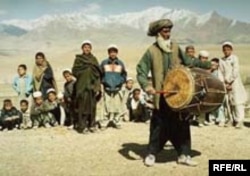PAKTIKA, Afghanistan -- Whether it announces a new birth, tackles a crime wave or issues a call to war, the drum continues to play a vital role in uniting and dividing people in Afghan society, especially in rural southeastern provinces.
In areas where mediums of mass communication have limited or no reach, drums are used to call public meetings on everything from civic education during elections to crime prevention forums.
The Independent Electoral Commission sent thousands of employees to explain electoral procedures to voters in different provinces in 2014, but it was the drum -- for example, in the remote southeastern province of Paktika -- that reminded them to vote.
"People didn’t want to risk their lives by going to the polling stations," says Rahim Shah, a resident in Paktika’s capital, Sharan. "However, there was an abrupt change in the number of voters as soon as the sound of the drum started to echo around the villages. Despite insecurity and having to travel long distances on foot, people came out and cast their votes."
To The Polls, Please!
Abdul Ghani Pakteen, a resident in the nearby district of Wali Khuli, says the drum was crucial in ensuring a good turnout during elections in his area, as well.
"The drum is mainly played when there is a need for people to become aware of an event," Pakteen says. According to the Wali Khuli resident, this was the case on June 14, the second and decisive round of the presidential election.
Men and women of all ages followed the sound of the drum on election day and proceeded en masse toward the polling stations, Pakteen says.
In areas where the central government has limited influence or presence, members of the community often meet to discuss a strategy to solve a given problem. One such example is crime prevention, says Gul Marjan, an elder in Barmal district.
After a spate of robberies in 2014, Barmal residents were called to a meeting to discuss crime prevention. A few weeks later, several arrests were made and the number of robberies went down. "It was the sound of the drum that brought people out and unified them to stand for their own security," says Gul Marjan, adding that the government had previously been unable to tackle the rise in violent crime.
Weapon of War
The drum effectively substitutes TV, radio and other mass media in many isolated areas of Afghanistan as a vehicle for public service announcements. In areas with irregular electricity supply, poor supply chains and limited signal, drummers ensure people remain informed of central issues in the community.
For example, if two neighboring villages are preparing for fighting -- often over land, water or forest -- a drum will call members of each community to understand the conflict and their responsibilities therein, Gul Marjan says.
Traditionally, the drum was used as a rallying cry to recruit young fighters into conflicts and to engender courage, but today drummers are more likely to be seen at a wedding than on the side of a battlefield.
Besides announcing births and weddings, drummers play special seasonal roles, like waking the faithful for a nighttime meal during the Islamic month of Ramadan, when people fast from dawn to dusk.
Sayed Rahman, 25, has been drumming at weddings and public forums for the past five years. He earns between $35 and $50 per event and is in particular high demand in the spring and summer seasons. Rahman says he was trained at the local barber shop.
"Besides cutting hair, these barbers play drums, work as waiters at wedding parties and even as postmen by delivering people's letters and invitations," Rahman says.
The Attan, the Afghan national dance performed by men at celebrations and events, usually accompanies the drum music at such events. Afghan drums are made of wood and covered in animal hides, and many Afghans believe drum beats were originally used to scare away wild animals from human settlements.
The drum has since become a vital tool in the implementation of Afghan democracy. "The drum is used to raise awareness of a risk that requires the community's consolidated efforts to settle it and solve it before it turns into a catastrophe," Pakteen says.






